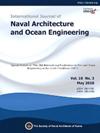Numerical study of inter-array cabling methods for two FOWTs in 150 m water depth
IF 3.9
3区 工程技术
Q2 ENGINEERING, MARINE
International Journal of Naval Architecture and Ocean Engineering
Pub Date : 2025-01-01
DOI:10.1016/j.ijnaoe.2025.100680
引用次数: 0
Abstract
Offshore wind farms transmit power via substations, with turbines interconnected to route electricity efficiently to shore-based substations. This study focuses on the safe transmission of power between two Floating Offshore Wind Turbines (FOWTs) using dynamic power cables. The research utilized FOWT models developed through the 12 MW INO WINDMOOR project. In this study, the models' reliability was enhanced by comparing experimental data with simulations conducted using OrcaFlex. Subsequently, four different cable connection methods were investigated and analyzed in terms of tension, curvature, and fatigue. The results indicate that the Lazy wave configuration performs best across all aspects. Although the Suspended and W-configurations exhibit lower rates of tension and curvature increase when transitioning from normal to extreme conditions, their absolute values remain significantly higher compared to the Lazy wave configuration. Additionally, the Catenary configuration may experience axial compression, which requires careful consideration during the design phase.
150m水深下两个fowt阵列间布线方法的数值研究
海上风电场通过变电站传输电力,涡轮机相互连接,有效地将电力输送到岸上的变电站。本研究的重点是两个浮动海上风力发电机(FOWTs)之间的电力安全传输使用动态电力电缆。该研究利用了通过12兆瓦inowindmoor项目开发的FOWT模型。在本研究中,通过将实验数据与使用OrcaFlex进行的模拟数据进行比较,提高了模型的可靠性。随后,对四种不同的电缆连接方法进行了张力、曲率和疲劳的研究和分析。结果表明,Lazy wave配置在所有方面都表现最好。虽然悬挂和w型结构在从正常到极端条件的过渡中表现出较低的张力和曲率增加率,但它们的绝对值仍然明显高于懒波结构。此外,接触网结构可能经历轴向压缩,这需要在设计阶段仔细考虑。
本文章由计算机程序翻译,如有差异,请以英文原文为准。
求助全文
约1分钟内获得全文
求助全文
来源期刊

International Journal of Naval Architecture and Ocean Engineering
ENGINEERING, MARINE-
CiteScore
4.90
自引率
4.50%
发文量
62
审稿时长
12 months
期刊介绍:
International Journal of Naval Architecture and Ocean Engineering provides a forum for engineers and scientists from a wide range of disciplines to present and discuss various phenomena in the utilization and preservation of ocean environment. Without being limited by the traditional categorization, it is encouraged to present advanced technology development and scientific research, as long as they are aimed for more and better human engagement with ocean environment. Topics include, but not limited to: marine hydrodynamics; structural mechanics; marine propulsion system; design methodology & practice; production technology; system dynamics & control; marine equipment technology; materials science; underwater acoustics; ocean remote sensing; and information technology related to ship and marine systems; ocean energy systems; marine environmental engineering; maritime safety engineering; polar & arctic engineering; coastal & port engineering; subsea engineering; and specialized watercraft engineering.
 求助内容:
求助内容: 应助结果提醒方式:
应助结果提醒方式:


